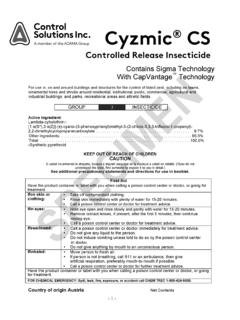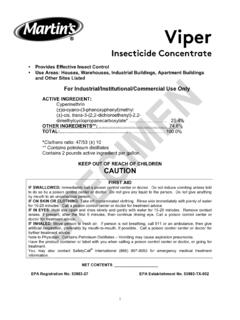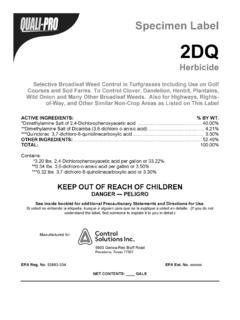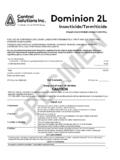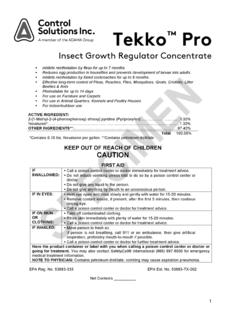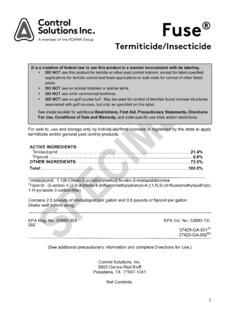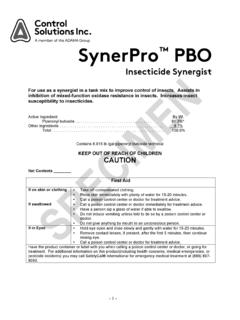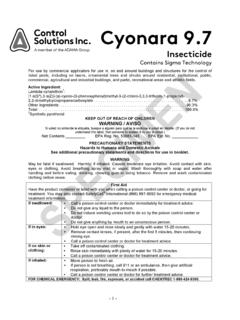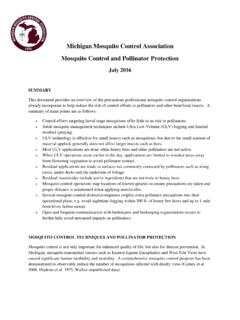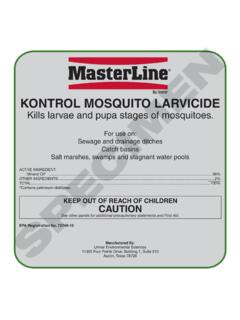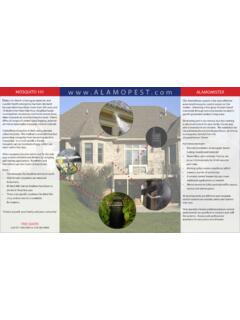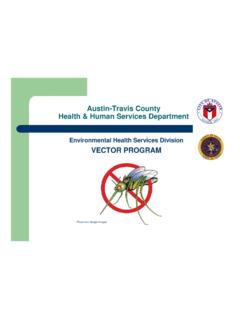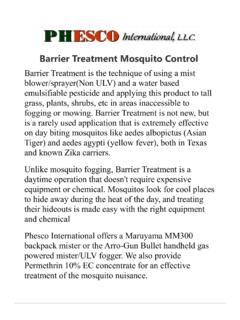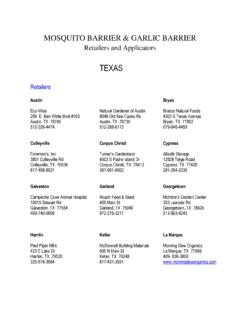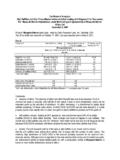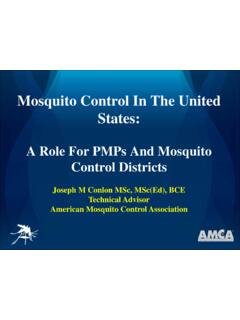Transcription of Stryker - Welcome to CSI- Control Solutions Inc.
1 1 Stryker Insecticide Concentrate Master Label Active Ingredients: Pyrethrins (CAS No. 8003-34-7) .. 6% Piperonyl butoxide* (CAS No. 51-03-6) .. 60% Other Ingredients .. 34% Total .. 100% *(butyl carbityl)(6-propylpiperonyl) ether and related compounds Keep Out of Reach of Children CAUTION See additional Precautionary Statements. EPA Reg. No. 53883-308 EPA Est. _____ Net Contents: {1 fluid ounce to 250 gallons} First Aid If Swallowed: Immediately call a poison Control center or doctor for treatment advice. Have person sip a glass of water if able to swallow.
2 Do not induce vomiting unless told to do so by a poison Control center or a doctor. Do not give anything by mouth to an unconscious person If on Skin or Clothing: Take off contaminated clothing. Immediately rinse skin with plenty of water for 15-20 minutes. Call a poison Control center or doctor for treatment advice. HOTLINE NUMBER Have the product container or label with you when calling the poison Control center or doctor or going for treatment. For additional information on Stryker (including health concerns, medical emergencies or pesticide incidents), you may call the National Pesticide Information Center at 1-800-858-7378, Monday through Friday from 7:30 AM to 3:30 PM Pacific Standard Time (PST).
3 After 3:30 PM PST and on weekends, call your National Poison Control Center at 1-800-222-1222. 2 PRECAUTIONARY STATEMENTS Hazards to Humans & Domestic Animals CAUTION: Harmful if swallowed. Prolonged or frequently repeated skin contact may cause allergic reactions in some individuals. Avoid contact with skin or clothing. Wash hands thoroughly with soap and water after handling and before eating, drinking, chewing gum, using tobacco or using the toilet. Personal Protective Equipment (PPE) Some materials that are chemical resistant to Stryker are made of barrier laminate, butyl rubber, nitrile rubber or viton.
4 If you want more options, follow the instructions for category E on an EPA Chemical resistance chart. Applicators and other handlers must wear: Long-sleeved shirt, Long pants, Chemical resistant gloves, Shoes plus socks, and Protective eyewear In addition to the above PPE, applicators using a high pressure handwand in an enclosed area must wear at least a NIOSH-approved respirator with a dust/mist filter with a MSHA/NIOSH-approval number prefix TC-21C or any N, R, P or HE filter. In addition to the above PPE, applicators using hand held foggers in an enclosed area must wear a half-face, full-face or hood-style NIOSH-approved respirator with: a dust/mist filtering cartridge (MSHA/NIOSH-approval number prefix TX-21C) or a canister approved for pesticides (MSHA/NIOSH-approval number prefix TX-14G) or a cartridge or canister with any N, R, P or HE filter.
5 See engineering controls for additional requirements. User Safety Requirements Follow manufacturer s instructions for cleaning/maintaining PPE. If no such instructions for washables exist, use detergent and hot water. Keep and wash PPE separately from other laundry. Discard clothing and other absorbent materials that have been drenched or heavily contaminated with the product s concentrate. Do not reuse them. Engineering Controls Pilots must use an enclosed cockpit that meets the requirements listed in the Worker Protection Standard (WPS) for agricultural pesticides (40 CFR (d)(6)).
6 Human flagging is prohibited. Flagging to support aerial application is limited to use of the Global Positioning System (GPS) or mechanical flaggers. User Safety Recommendations Users should: Wash hands before eating, drinking, chewing gum, using tobacco or using the toilet. Remove clothing/PPE immediately if pesticide gets inside. Then wash thoroughly and put on clean clothing. Remove PPE immediately after handling Stryker . Wash the outside of gloves before removing. As soon as possible, wash thoroughly and change into clean clothing. Environmental Hazards for Terrestrial Applications Stryker is toxic to aquatic organisms, including fish and invertebrates.
7 Drift and runoff may be hazardous to aquatic organisms in water adjacent to treated areas. Stryker may contaminate water through runoff. Stryker has a potential for runoff for several weeks after application. Poorly draining soils and soils with shallow water tables are more prone to produce runoff that contains Stryker . Stryker is highly toxic to bees exposed to direct treatment on blooming crops or weeds. Do not apply Stryker or allow it to drift to blooming crops or weeds while bees are actively visiting the treatment area. 3 Except as specified in the Directions for Use, do not apply directly to water to areas where surface water is present or to intertidal areas below the mean high water mark.
8 Do not contaminate water when disposing of equipment wash waters or rinsate. [Environmental Hazards Statement for mosquito Adulticide Sub-label: This pesticide is toxic to aquatic organisms, including fish and invertebrates. Run off from treated areas or deposition of spray droplets into a body of water may be hazardous to fish and aquatic invertebrates. When applying as a wide area mosquito adulticide before making the first application in a season, it is advisable to consult with the state or tribal agency with primary responsibility for pesticide regulation to determine if other regulatory requirements exist.]
9 Stryker is highly toxic to bees exposed to direct treatment of blooming crops or weeds. Do not apply Stryker or allow it to drift to blooming crops or weeds while bees are actively visiting the treatment area. except when applications are made to prevent or Control a threat to public and/or animal health determined by a state, tribal or local health or vector Control agency on the basis of documented evidence of disease causing agents in vector mosquitoes or the occurrence of mosquito -borne disease in animal or human populations, or if specifically approved by the state or tribe during a natural disaster recovery effort.
10 When applying as a wide area mosquito adulticide, do not apply over bodies of water (lakes, rivers, permanent streams, natural ponds, commercial fish ponds, swamps, marches, or estuaries) except when necessary to target areas where adult mosquitoes are present and weather conditions will facilitate movement of applied material away from the water in order to minimize incidental deposition into the water body.] DIRECTIONS FOR USE It is a violation of Federal law to use Stryker in a manner of inconsistent with its labeling.
